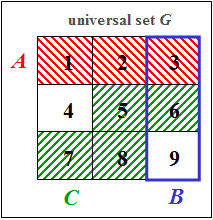Let the universal set $G$ be the set of all digits between $1$ and $9$. Given are the following subsets:
- $$A = \big[\text{digits} \leqslant 3\big],$$
- $$ B = \big[\text{digits divisible by 3}\big],$$
- $$ C = \big[\text{digits 5, 6, 7, 8}\big].$$
Besides these, let other sets be defined:
- $$D = (A \cap \overline B) \cup (\overline A \cap B),$$
- $$E = (A \cup B) \cap (\overline A \cup \overline B), $$
- $$F = (A \cup C) \cap \overline B, $$
- $$H = (\overline A \cap \overline C) \cup (A \cap B \cap C).$$
First consider which digits belong to the sets $D$, $E$, $F$ and $H$ and then answer the following questions.
Justify your answers in terms of set theory.
Hints:
- The task belongs to the chapter Set Theory Basics.
- The topic of this chapter is illustrated with examples in the (German language) learning video
- Mengentheoretische Begriffe und Gesetzmäßigkeiten $\Rightarrow$ "Set Theoretical Concepts and Laws".
Questions
Solution
For the other sets defined in the problem holds:
- $$ D = (A \cap \overline B) \cup (\overline A \cap B) =\big[\{1, 2, 3\} \cap \{1, 2, 4, 5, 7, 8\}\big] \cup \big[\{4, 5, 6, 7, 8, 9\} \cap \{3, 6, 9\}\big] = \{1, 2, 6, 9\},$$
- $$ E = (A \cup B) \cap (\overline A \cup \overline B) = (A \cap \overline A) \cup (A \cap \overline B) \cup (\overline A \cap B) \cup (\overline A \cap \overline B) = (A \cap \overline B) \cup (\overline A \cap B) = D = \{1, 2, 6, 9\},$$
- $$F = (A \cup C) \cap \overline B = \{1, 2, 3, 5, 6, 7, 8\} \cap \{1, 2, 4, 5, 7, 8\} = \{1, 2, 5, 7, 8\},$$
- $$H = (\bar A \cap \overline C) \cup (A \cap B \cap C) = (\overline A \cap \overline C) \cup \phi = \{4, 9\}.$$
(1) Only the proposed solution 2 is correct:
- $A$ and $C$ have no common element.
- $A$ and $B$ each contain a $3$.
- $B$ and $C$ each contain a $6$.
(2) Correct is the proposed solution 2:
- No digit is contained in $A$, $B$ and $C$ at the same time ⇒ $ A \cap B \cap C = \phi$ ⇒ $ \overline{A \cap B \cap C} = \overline{\phi} = G$.
- The first proposition, on the other hand, is wrong. It is missing a $4$.
(3) Correct are the proposed solutions 1, 2 and 4:
- The first proposal is correct: The sets $D$ and $E$ contain exactly the same elements and thus also their complementary sets.
- The second proposal is also correct: In general, i.e. for any $X$ and $B$ the following holds: $(X \cap \overline B) \subset \overline B \ \Rightarrow$ With $X = A \cup C$ it follows that $F \subset \overline B$.
- The last proposal is also correct: $A = \{1, 2, 3\},$ $C = \{5, 6, 7, 8\}$ and $H = \{4, 9\}$ form a "complete system".
- The third suggestion, on the other hand, is wrong because $B$ and $C$ are not disjoint.
